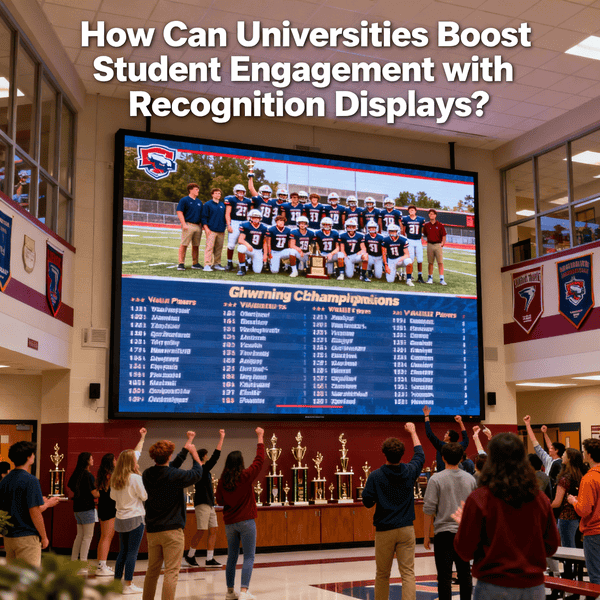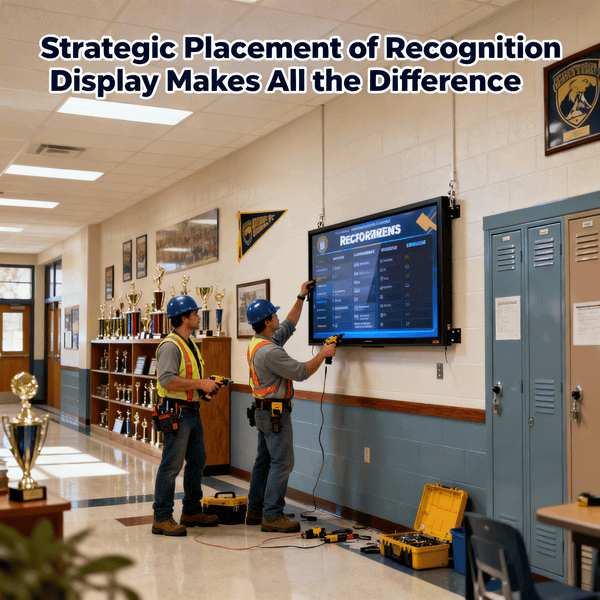These days, while wandering around any campus, there is that view of students gripping their phones, scrolling through social media on fellow students’ achievements, milestones, and celebrations. This generation craves recognition and connection; yet institutions of higher learning continue to vest recognition in foiled-in-glass trophy cases and boring bulletin boards. Isn’t it time to bridge the gap between student expectations and institution delivery?

Table of Contents
What Student Recognition Displays Do
Recognition displays aren’t created for bragging rights alone; they strengthen community-building efforts that instill pride in the pursuit of excellence and belonging in students. By way of creative installations, recognition displays transform how students relate to their universities and to one another. How can colleges and universities effectively use such recognition displays to really engage students?
The Recognition Gap in Understanding
The student today is raised in an environment of instant gratification and immediate feedback. They wished that likes, shares, and comments would serve as acknowledgment of their effort in almost real-time. Just this—maybe the annual awards ceremony or plaques that include one’s name—fails to resonate anymore with the student. The more antique the award presentation, the more impersonal it appears and the more distant it feels from their life experiences.
Another challenge for universities’ administration these days is finding means to acknowledge students in ways that feel sincere and relevant to what they are doing. Students want their accomplishments to be recognized in places where they actually spend time rather than in concealed university buildings or disused corridors. Furthermore, they want recognition reflecting on the various other ways by which they help life on campus and not just academic distinctions; community services, creative works, and leadership initiatives are very important, too.
The Power of Digital Recognition Solutions
In the modern world of technology lies an endless reservoir of opportunities for universities to revolutionize the means by which they celebrate their student success. Hall of fame digital signage is very much a disruption for institutions that want to take a step toward a more dynamic experience of recognition. These displays can highlight real-time achievements so that recognition stays fresh and relevant by rotating amongst different students and different accomplishments during a given day.
Traditional recognition displays were limited by their static nature, barring universities from showcasing a wider scope of achievements and from constantly updating their content. Digital displays can feature everything from dean’s list honorees to student research presentations and athletic accomplishments to community service milestones in celebration of every form of excellence students have displayed. This versatility serves to express appreciation for more students.
Creating Interactive Recognition Experiences
In moving recognition one level up, many forward-thinking universities have identified a new breed of technologies that can empower and invite students to interact with the celebration displays. The interactive touchscreen wall of fame turns the patient’s stage into an active one. Students can explore profiles of high achievers, discover scholarship opportunities and student organizations, and then proceed to share not only their achievements but also those of their fellow students on social media channels.
These cross-platform displays serve as the natural hangout for students, where they will pause and check out opportunities and values of their institution, making recognition the base of marketing instead of a one-way announcement. With recognition displaying interactivity, students remember the message better and get motivated to monitor their own achievements.
Strategic Placement Makes All the Difference

If a recognition display is so high in tech sophistication but is hidden from view, it can never enhance engagement. Think high traffic areas where students congregate naturally. Student unions, dining halls, entrances to libraries, recreation centers, and main thoroughfares across campus are prime real estate. Naturally, the idea is to get recognition drilled into students’ occupation instead of making them chase after it.
Think about creating recognition hubs where students can chill out between classes on soft couches with charging stations and the digital displays. The best thing about these spaces is that they’re a landfill for peer-to-peer recognition. Embedding recognition in the physical landscape students negotiate every day would lay an excellent foundation for excellence and appreciation.
Also Read: Xiaomi 16 Pro Max Dual Display Smartphone – Everything You Need to Know
Making Recognition Inclusive and Diverse
In order for recognition to successfully become a conduit through which more engagement arises, displays must truly reflect the diversity of your student body as well as the types of achievements they honor. Academic achievements are important, but so are artistic achievements, community service, peer mentoring, entrepreneurial ventures, and cultural contributions. Students will engage more deeply when they see people like themselves celebrated for achievements that matter to them.
Rotate the types of accomplishments featured on the displays frequently to ensure various student groups feel acknowledged and valued. Celebrate not only the traditional stars but also the unsung heroes who enrich campus life. Recognize students from an array of majors, backgrounds, and levels of engagement. This type of inclusive recognition nurtures the kind of campus culture where everyone feels like they belong and have the opportunity to excel.
Measuring Impact and Gathering Feedback
Launching new recognition models is but a beginning toward engagement promotion; universities have to assess the efficiency of new recognition programs and keep improving the recognition concept. Try and get feedback from all your students by asking what types of recognition statements count the most for them to see and where they want to see such statements placed. Track engagement metrics for the interactive displays to find what content best resonates.
Consider surveying students about how recognition displays influence their feelings of belonging and motivation. This data will support investment in modern recognition systems and will guide future improvements. Should the student notice their opinions are met in action, they thusly will feel even more connected as well as consider their voice is being taken into account.
Conclusion: Recognition as Community Building
Recognition displays are the feel-good battalion of any campus infrastructure. They are tools in creating a campus community that is as engaged as it is motivated. By adopting present-day technology and organization concepts, the institutions will surely change the face with which acknowledgment and celebration are perceived by students.
The real crux of the matter is to meet students where they are: physically and culturally. Modern, interactive, and inclusive recognition displays speak to today’s students but also hold tight onto the timeless ideals of excellence and achievement. Next time you weigh alternatives for engaging students on your campus, ask yourself this: Are your recognition systems celebrating students in ways that actually resonate with them?







